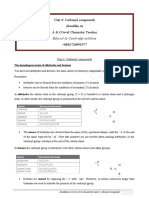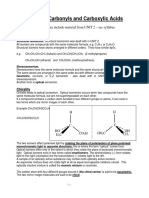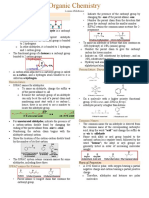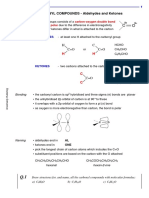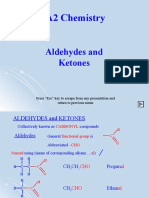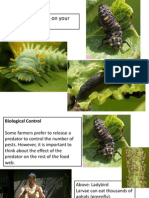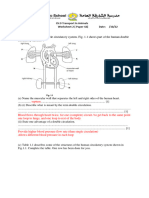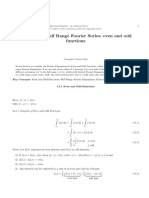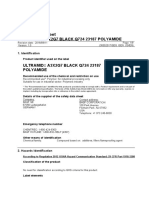Carbonyl compounds; aldehydes and ketones
The (C=O) functional group is often called the carbonyl group. Aldehydes and
ketones are therefore known as carbonyl compounds. In aldehydes, the functional
group is found at the end of a carbon chain, in ketones it is found in the middle.
H H
H O
O
H C C
H C C C H
H
H H H
ethanal – aldehyde propanone - ketone
Aldehydes are named using the ending –al. The carbon atom in the carbonyl group
is always counted as number one when naming side-chains. Ketones are named
using the ending –anone.
H H H H H O H H
O
H C C C C H C C C C C H
H
H H CH3 H H H H
2-methylbutanal pentan-3-one
NOT
3-methylbutanal
Note: the short-hand formula of an aldehyde must end in –CHO and not –COH as
the latter shows the hydrogen bonded to the oxygen – this is not the case in
aldehydes. e.g. ethanal is CH3CHO, propanone is CH3COCH3.
Making aldehydes & ketones
To make aldehydes, a primary alcohol is heated in a distillation apparatus with a
limiting amount of potassium dichromate in dilute sulphuric acid.
e.g. H
. O
H C OH + [O] H C + H2O
H
H
thermometer
water
out
excess
alcohol
+ K2Cr2O7 / condenser
dil H2SO4
heating aldehyde
water
mantle
in
� To make ketones, a secondary alcohol is heated in a reflux apparatus with an
excess of potassium dichromate in dilute sulphuric acid.
H H H H H
H C C C H + [O] H C C C H + H2 O
H OH H H O H
water out
condenser
water in
round-bottomed flask containing
excess K2Cr2O7/H2SO4 and alcohol
heating mantle
Testing for the carbonyl group
The presence of the carbonyl group in aldehydes and ketones can be detected by
adding a few drops of 2,4-dinitrophenylhydrazine solution (“Brady’s reagent”),
when a condensation reaction occurs to give orange precipitates. These
precipitates can be filtered off, purified via recrystalisation and then identified by
their melting points. There are several data bases which contain the melting points
of hundreds of 2,4-DNPH derivatives.
e.g.
H
H H H
H
N N NO2
O N N NO2
H C C
H C C H
H
H
H
+ H2O
H
NO2 NO2
2,4-dinitrophenylhydrazine a phenylhydrazone
(orange solid, melting point 164 C)
As both aldehydes and ketones both undergo this reaction, a further test is needed
to distinguish between the two families.
�Tests to distinguish between aldehydes and ketones
As was seen in module 2, whilst aldehydes can be oxidized to carboxylic acids,
ketones are not readily oxidized. This fact underlies both of the common tests which
are used to distinguish between aldehydes and ketones. Both Tollen’s reagent
(ammoniacal silver nitrate) and acidified potassium dichromate agents are
oxidizing agents which react with aldehydes but not ketones.
CH3CHO + [O] CH3COOH
CH3COCH3 + [O] no reaction
a) The addition of Tollen’s reagent (ammoniacal silver nitrate) with warming
Whilst ketones undergo no reaction, aldehydes produce a silver mirror on the
reaction vessel. The aldehyde reduces the silver ions to silver metal.
b) The addition of acidified potassium dichromate with warming
When heated with aldehydes, the orange Cr2O72- ions are reduced to Cr3+ ions
which are green. Ketones do not react.
Aldehydes, ketones and redox reactions
In module 2, aldehydes and ketones were first met as the products obtained when
various alcohols are oxidized. Unsurprisingly, the reverse reduction reactions, are
also possible:
Primary oxidation Aldehyde oxidation Carboxylic
alcohol acid
reduction reduction
e.g. H
. O O
R C OH R C R C
H O H
H
Secondary oxidation Ketone oxidation
alcohol No reaction
reduction reduction
e.g. H
. O
R C OH R C
R
R
Tertiary oxidation
alcohol No reaction
The are two reducing agents commonly used in organic chemistry – lithium
aluminium hydride (LiAlH4) and sodium borohydride (NaBH4). The latter reagent
�is used to reduce aldehydes and ketones whilst LiAlH4 is needed to reduce
carboxylic acids.
Reagents: aldehyde/ketone + sodium borohydride
Conditions: aqueous solution, add dilute hydrochloric acid to finish
Equation: H H H
O
H C C + 2[H] H C C OH
H
H H H
H H H H H
H C C C H + 2[H] H C C C H + H2 O
H O H H OH H
The reduction mechanism: nucleophilic addition
Due to the high electronegativity of oxygen, aldehydes and ketones are strongly
polar. This means the carbonyl carbon atom is readily attacked by nucleophiles:
-
O
+
R C
Nucleophilic attack
H
Sodium borohydride [or sodium tetrahydridoborate(III),NaBH4] is a source of hydride
-
(H ) ions. As these ions have a pair of electrons in their outer shell, they act as
-
nucleophiles. As the H nucleophiles donate their lone pairs to the + carbon atom
in the C=O group, the weak -bond breaks. This leads to a carbanion intermediate
which then reacts with water or acid to form the alcohol. This mechanism is known
as nucleophilic addition.
+
- H
- :O OH
O
+
R C R C R’ R C R’
R’
H H
-
:H carbanion alcohol
intermediate
(R and R’ are alkyl groups or hydrogen atoms)













